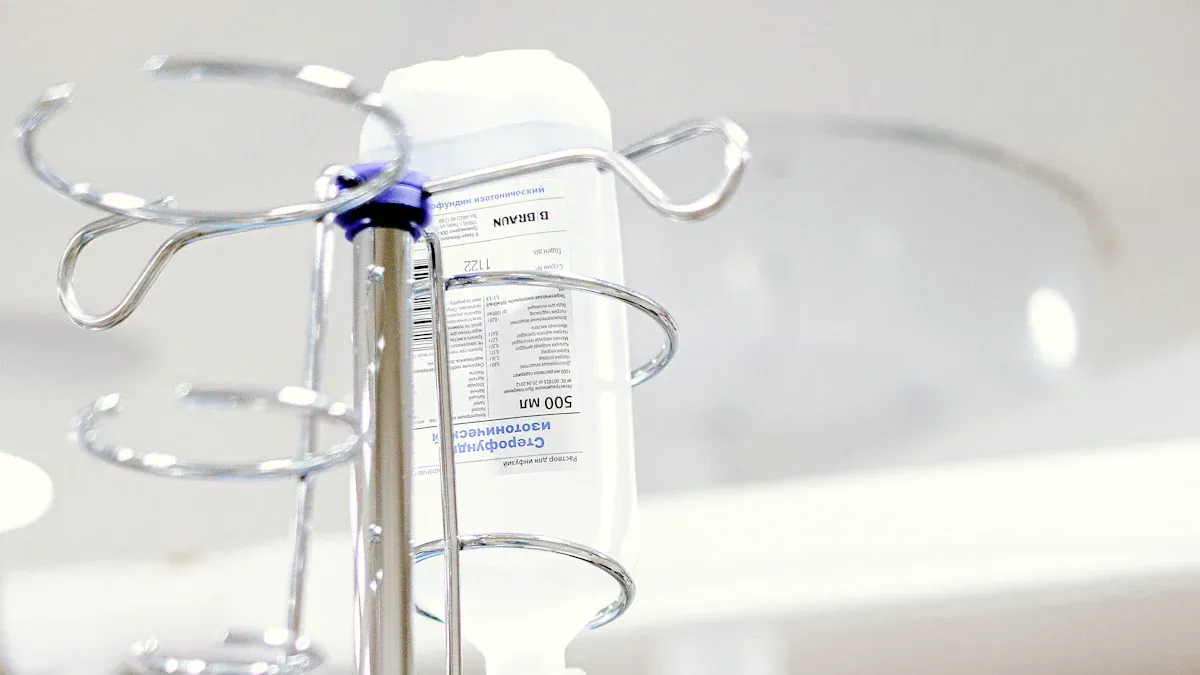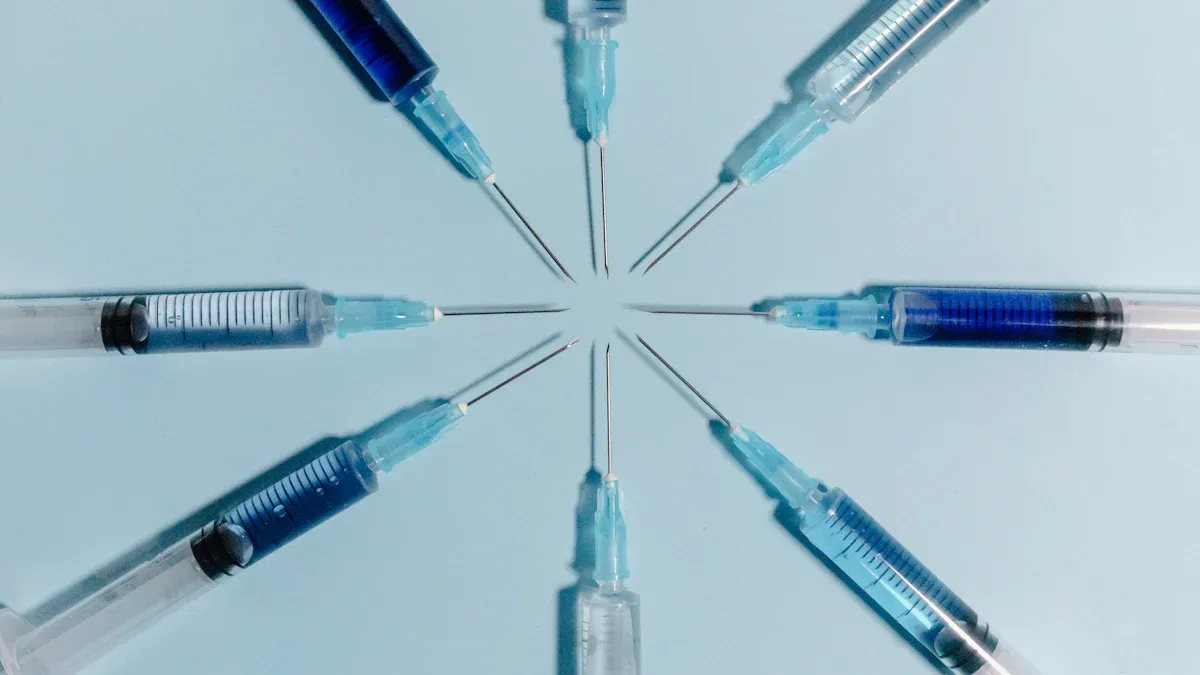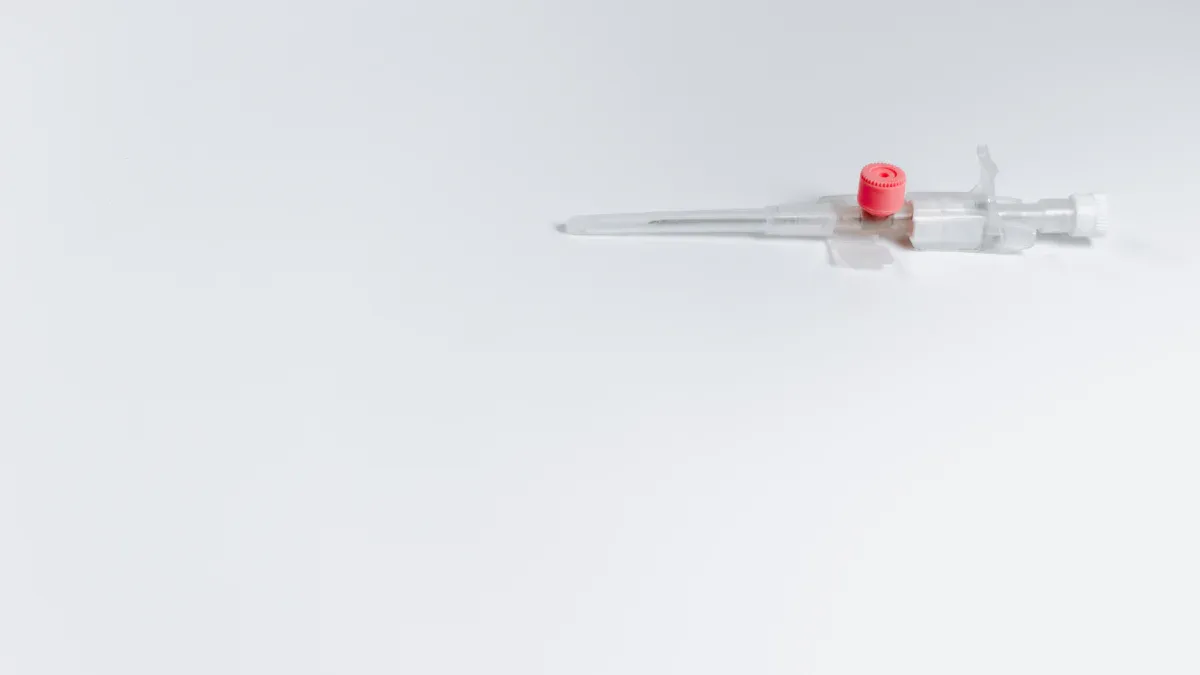What is PET Heat Shrink Tubing for Medical Catheters

Polyethylene Terephthalate (PET) heat shrink tubing delivers unmatched durability and safety in medical device applications. Its biocompatible composition ensures compatibility with human tissues, making it ideal for use in external and implantable devices. This tubing provides essential reinforcement for medical catheters, enhancing their structural integrity and protecting sensitive components.
PET heat shrink tubing excels in demanding environments due to its resilience. It resists kinking and deformation, ensuring fluid flow remains uninterrupted. Its ability to tolerate extreme temperatures, ranging from -196°C to 135°C long-term, makes it suitable for sterilization processes. These qualities make PET heat shrink tubing for medical catheter reinforcement a preferred choice among healthcare professionals.
Key Takeaways
PET heat shrink tubing is strong and safe for medical tools like catheters.
It handles very hot or cold temperatures and tough chemicals, staying reliable in hospitals.
The tubing stops bending and helps catheters work better, allowing fluids to flow smoothly during use.
PET tubing follows strict safety rules, proving it is safe for patients in many medical uses.
It is good for the environment and affordable, making it popular with healthcare manufacturers.
Properties of Medical-Grade PET Heat Shrink Tubing

Mechanical Strength and Tear Resistance
Medical-grade PET heat shrink tubing demonstrates exceptional mechanical strength, making it ideal for demanding medical applications. Its tensile strength ensures durability under mechanical stress, allowing it to maintain its structural integrity over time. This characteristic is particularly important for catheters, which require reinforcement to withstand repeated use and manipulation during procedures.
The tubing also exhibits remarkable tear resistance, preventing damage during installation or operation. Its flexibility allows it to conform to intricate shapes and components, ensuring secure insulation without compromising performance. These properties make PET heat shrink tubing a reliable choice for medical devices that demand both strength and adaptability.
Feature | Description |
|---|---|
Tensile Strength | Resists mechanical stress and ensures long-term durability. |
Tear Resistance | Prevents damage during installation and operation. |
Flexibility | Conforms to intricate shapes and components for secure insulation. |
Thermal Stability and Chemical Resistance
PET heat shrink tubing excels in thermal stability, maintaining its protective properties under extreme temperatures. It can endure long-term temperatures ranging from -196°C to 135°C and short-term exposure up to 200°C. This heat-shrinkable material is effective in autoclave sterilization processes, ensuring its suitability for medical environments.
Its chemical resistance further enhances its performance. PET tubing withstands exposure to harsh cleaning agents and disinfectants, preventing degradation and ensuring the longevity of medical devices. These qualities make it indispensable for applications requiring durability in challenging conditions.
PET heat shrink tubing offers excellent temperature resistance, maintaining its protective properties under both high and low temperatures.
It can handle short-term temperatures up to 200°C and has a melting point of 235°C.
The tubing resists degradation from exposure to disinfectants and sterilization agents, ensuring long-term reliability.
Property | Measurement |
|---|---|
-196°C to 135°C | |
Short-term Temperature Range | Up to 200°C |
Melting Point | 235°C |
Chemical Resistance | Prevents degradation from cleaning agents. |
Biocompatibility and Safety for Medical Applications
Medical-grade PET heat shrink tubing meets stringent biocompatibility standards, ensuring its safety for use in medical applications. It complies with ISO 10993 and USP Class VI standards, confirming its compatibility with human tissues. FDA and CE approvals further validate its reliability for global medical use.
The tubing retains its structural integrity and performance after repeated sterilization cycles, whether through heat-based, radiation, or chemical methods. Its smooth surface minimizes bacterial growth, which is crucial for maintaining sterility in medical environments. Additionally, its non-toxic composition reduces the risk of adverse reactions during procedures, making it suitable for applications such as catheter insulation and sensor encapsulation.
Sterilization Method | Evidence |
|---|---|
Heat-based (Autoclaving) | Maintains structural integrity and performance after repeated cycles. |
Radiation (Gamma, E-beam) | Retains chemical and physical properties without significant degradation. |
Chemical (Hydrogen Peroxide) | Retains over 88% of tensile strength after 50 cycles of sterilization. |
PET heat shrink tubing meets ISO 10993 and USP Class VI standards, confirming biocompatibility and safety.
Its smooth surface reduces bacterial growth, ensuring sterility in medical environments.
FDA and CE approvals establish compliance with global regulatory requirements.
Applications of PET Heat Shrink Tubing for Medical Catheter Reinforcement

Insulation and Protection of Sensitive Components
PET heat shrink tubing plays a critical role in protecting sensitive medical devices, particularly in catheter systems. Its dielectric strength, exceeding 600 V/mil, ensures reliable insulation for components exposed to electrical currents. This property is especially important in cardiovascular interventions, where electrical safety is paramount. PET tubing also secures microfluidic channels and sensors in drug delivery systems, preventing degradation caused by pharmaceuticals.
In robotic surgical tools, PET tubing insulates force feedback sensors, which are essential for maintaining precision and preventing cross-contamination in disposable instruments. Additionally, its ability to withstand high-temperature sterilization protocols ensures that sensitive components remain protected during repeated use.
Application | Evidence |
|---|---|
Drug Delivery Systems | PET tubing secures microfluidic channels and sensors, preventing degradation from pharmaceuticals. |
Cardiovascular Interventions | PET tubing's dielectric strength (exceeding 600 V/mil) ensures safe operation in catheter systems. |
Robotic Surgical Tools | Insulates force feedback sensors, crucial for preventing cross-contamination in disposable tools. |
Sterilization Protocols | High-temperature sterilization methods impose strict resistance thresholds on PET tubing materials. |
By providing a tight and secure seal, PET heat shrink tubing ensures that sensitive components remain insulated and protected, even in the most demanding medical environments.
Strengthening Catheter Shafts and Marker Bands
PET heat shrink tubing for medical catheter reinforcement enhances the structural integrity of catheter shafts and marker bands. Its mechanical strength and flexibility allow it to conform to intricate shapes while providing robust support. This combination of properties ensures that catheters maintain their functionality during repeated use and manipulation.
Marker bands, which are critical for precise positioning during procedures, benefit from the added reinforcement provided by PET tubing. The tubing's ability to create a tight and secure seal ensures that marker bands remain in place, even under mechanical stress. This reliability is essential for the development of medical implants and other advanced devices that require precision and durability.
The non-toxicity of PET tubing further enhances its suitability for medical applications. Its biocompatible nature ensures that it can be safely used in implants without causing adverse reactions. This makes PET tubing an indispensable material for strengthening catheter components and improving their overall performance.
Enhancing Performance and Preventing Kinking
Kinking in catheters can disrupt fluid flow and compromise the success of medical procedures. PET heat shrink tubing addresses this issue by enhancing the axial and torsional stiffness of catheter systems. Its semi-flexible design allows it to provide the necessary support without sacrificing flexibility and ease of application.
The tubing's ability to prevent kinking is further enhanced by its compatibility with multi-layered designs. For example, a catheter system may include a PVC outer jacket, a stainless steel spring, and PET heat shrink tubing to achieve optimal stiffness. Customizable solutions, such as adding rings of heat shrink along the flexible segment, allow manufacturers to tailor the stiffness to specific requirements.
The semi-flexible segment of the guide tube includes PET medical heat shrink to enhance axial and torsional stiffness.
The design incorporates multiple layers, including a PVC outer jacket and a stainless steel spring, which contribute to the overall stiffness and kinking prevention.
Adjustments to stiffness can be made by adding rings of heat shrink along the flexible segment, indicating a customizable approach to prevent kinking.
By preventing kinking and ensuring improved durability and longevity, PET heat shrink tubing significantly enhances the performance of catheter systems. Its role in maintaining the structural integrity of catheters makes it a preferred choice for medical professionals and manufacturers alike.
Benefits of PET Heat Shrink Tubing in Medical Catheters
Durability and Longevity in Medical Environments
PET heat shrink tubing offers exceptional durability, making it a reliable choice for medical applications. Its robust mechanical properties allow it to withstand repeated use without compromising performance. This durability is crucial in medical environments where devices like catheters undergo frequent handling and sterilization. PET tubing retains its structural integrity even after exposure to extreme temperatures and harsh cleaning agents, ensuring long-term reliability.
The material's resistance to wear and tear also contributes to its longevity. PET tubing maintains its protective properties over time, reducing the need for frequent replacements. This durability not only enhances the performance of medical devices but also minimizes costs associated with maintenance and repairs.
Safety and Reliability for Patients and Professionals
PET heat shrink tubing ensures safety and reliability in medical applications. Its biocompatible nature prevents adverse reactions when in contact with human tissue, making it suitable for sensitive procedures. The tubing complies with stringent safety standards, including ISO 10993-1:2018, FDA regulations, and CE marking requirements. These certifications confirm its reliability for global medical use.
Standard | Description |
|---|---|
ISO 10993-1:2018 | Framework for biological evaluation of medical devices, including risk management. |
FDA Regulations | Ensures material sourcing and sterilization compatibility for patient safety. |
CE Marking | Confirms compliance with EU Medical Device Regulation for diagnostic devices. |
PET tubing's smooth surface minimizes bacterial growth, further enhancing patient safety. Its ability to maintain performance after sterilization ensures that medical professionals can rely on it during critical procedures. Applications such as catheter reinforcement and surgical tool insulation highlight its versatility and dependability.
PET tubing is biocompatible, ensuring no adverse reactions with human tissue.
It meets stringent safety standards, confirming its reliability in medical applications.
Applications include catheter reinforcement, surgical tool insulation, and wire harnessing.
Ease of Use in Manufacturing and Assembly Processes
PET heat shrink tubing simplifies the manufacturing of catheters and other medical devices. Its compatibility with heat-based sterilization methods, such as autoclaving, ensures seamless integration into production workflows. The tubing's flexibility and strength make it easy to apply, even to intricate components, without compromising performance.
Evidence Description | Key Benefit |
|---|---|
PET tubing meets ISO 10993 and USP Class VI standards, confirming its biocompatibility and safety. | Biocompatibility and safety for medical applications. |
Offers superior strength and reliability in encapsulation of sensitive components. | Enhanced reliability in medical device manufacturing. |
Demonstrates exceptional compatibility with heat-based sterilization methods, particularly autoclaving. | Ideal for sterilization processes. |
Excels in applications requiring moisture resistance and fluid management. | Maintains integrity in humid or fluid-exposed environments. |
Manufacturers benefit from PET tubing's ability to conform to complex shapes, ensuring a secure fit for various components. Its moisture resistance and fluid management capabilities further enhance its usability in humid environments. These features make PET tubing an indispensable material in the production of reliable and high-performing medical devices.
Why PET Heat Shrink Tubing is a Preferred Choice
Comparison with Alternative Materials in Medical Tubing
PET heat shrink tubing stands out when compared to other materials commonly used in medical tubing applications. Its eco-friendly nature makes it a sustainable choice, helping manufacturers reduce their carbon footprint without compromising quality. Unlike cold shrink tubing, PET offers superior durability and operates effectively across a broader temperature range. This reduces the frequency of replacements, making it a more reliable option for long-term use.
The tubing's shrink ratio of up to 75% allows it to conform to irregular shapes, a feature unmatched by PVC, which only offers a 2:1 ratio. PET also outperforms PVC in terms of thermal resistance, with a maximum operating temperature of 125ºC (257ºF) compared to PVC's limit of 85ºC (185ºF). Its exceptional tensile strength and durability ensure consistent performance in demanding medical environments, making it a preferred choice for applications requiring precision and reliability.
PET tubing is eco-friendly, reducing environmental impact.
It offers a wider temperature range and greater durability than cold shrink tubing.
Its shrink ratio of up to 75% surpasses PVC's 2:1 ratio.
PET withstands higher temperatures, ensuring reliability in sterilization processes.
Cost-Effectiveness and Production Efficiency
PET heat shrink tubing delivers significant cost advantages for manufacturers. Its durability minimizes the need for frequent replacements, reducing long-term expenses. The material's compatibility with automated production processes further enhances efficiency, allowing manufacturers to streamline workflows and lower labor costs.
The global market for PET tubing reflects its growing demand across industries, including healthcare. With a projected compound annual growth rate (CAGR) of 6.2% from 2023 to 2030, the market is estimated to reach USD 858.14 million. Its widespread availability ensures consistent supply, making it a practical choice for large-scale production.
Metric | Value |
|---|---|
Projected CAGR (2023-2030) | 6.2% |
Estimated Market Value | USD 858.14 million |
Key Industries | Automotive, Healthcare, Electronics |
Availability | Widely available globally |
Proven Success in Medical Device Applications
PET heat shrink tubing has demonstrated consistent success in medical device applications. Its biocompatibility and compliance with stringent safety standards make it suitable for use in catheters, surgical tools, and diagnostic devices. The tubing's ability to withstand sterilization processes ensures its reliability in environments where hygiene is critical.
Manufacturers rely on PET tubing for its versatility and performance. It provides insulation for sensitive components, reinforces catheter shafts, and prevents kinking in flexible medical devices. These qualities have made it a cornerstone material in advancing medical technology, contributing to improved patient outcomes and device longevity.
PET heat shrink tubing continues to set the standard for reliability and innovation in medical applications. Its proven track record underscores its value as a trusted material for healthcare professionals and manufacturers alike.
PET heat shrink tubing plays a vital role in enhancing the functionality and reliability of medical catheters. Its unique properties, such as electrical insulation, environmental resistance, and biocompatibility, ensure safe and efficient operation in demanding medical environments. The tubing withstands sterilization cycles, resists moisture and chemicals, and conforms tightly to components, reducing mechanical failure risks. These qualities make PET tubing indispensable for applications requiring precision and durability.
By advancing catheter technology, PET heat shrink tubing contributes to improved patient care and medical device innovation. Its compact design and ability to prevent wear and tear ensure long-term performance, supporting healthcare professionals in delivering effective treatments.
PET heat shrink tubing continues to set the standard for reliability and safety in medical applications, driving progress in healthcare technology.
FAQ
What is PET heat shrink tubing used for in medical applications?
PET heat shrink tubing is used to reinforce and insulate medical devices like catheters. It protects sensitive components, enhances structural integrity, and prevents kinking. Its biocompatibility ensures safety for patients during procedures.
How does PET tubing improve catheter performance?
PET tubing strengthens catheter shafts, prevents kinking, and ensures smooth fluid flow. Its flexibility and durability allow it to conform to intricate designs while maintaining structural support, making it essential for reliable catheter performance.
Is PET heat shrink tubing safe for medical use?
Yes, PET heat shrink tubing meets stringent safety standards, including ISO 10993 and USP Class VI. Its biocompatibility and resistance to sterilization processes make it safe for use in medical environments.
Can PET tubing withstand sterilization processes?
PET tubing tolerates high-temperature sterilization methods like autoclaving. It retains its structural integrity and performance after repeated cycles, ensuring long-term reliability in medical applications.
Why is PET preferred over other materials for medical tubing?
PET offers superior durability, thermal resistance, and a higher shrink ratio compared to alternatives like PVC. Its biocompatibility and ability to withstand sterilization make it a preferred choice for medical tubing.
See Also
The Role of FEP Heat Shrink Tubing in Catheter Design
The Importance of Ultra-Thin PET Tubing in Medical Equipment
Essential Insights on PET Heat Shrink Tubing for Electronics

